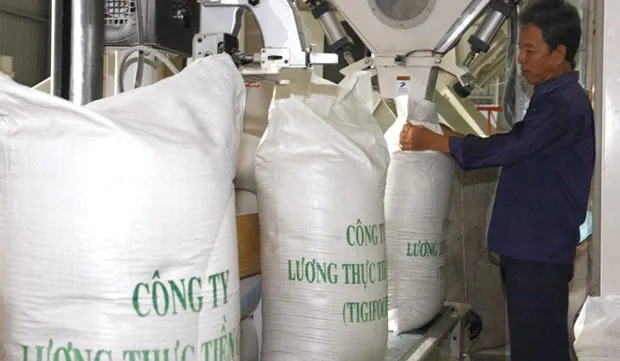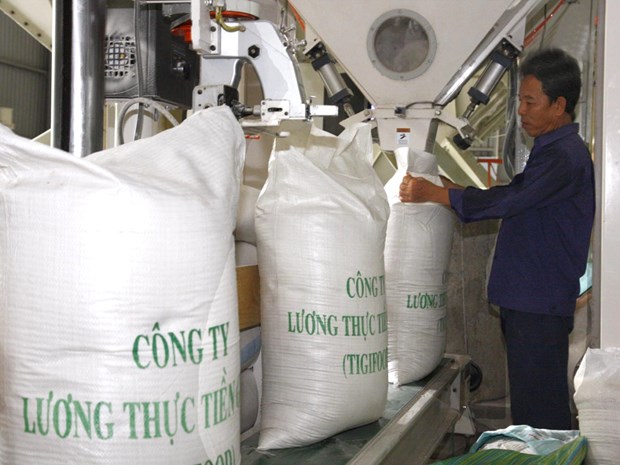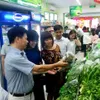Việt Nam sets plan to build stable export market in China
by ,http://vietnamnews.vn/economy/535387/viet-nam-sets-plan-to-build-stable-export-market-in-china.html14 September 2019 Last updated at 08:08 AM
Comments0

China is the largest export market of Việt Nam, accounting for 27 per cent of the country’s total export turnover.

Rice packaging line at the Việt Nam Southern Food Corporation (Vinafood 2). — VNA/VNS Photo Đình Huệ
HÀ NỘI Việt Nam wants to work with China to boost export growth, creating a stable market for agriculture products, said Minister of Industry and Trade (MoIT) Trần Tuấn Anh.
Speaking at a conference on exports of agricultural products and seafood to China held in Hà Nội yesterday, Anh said the co-operation was expected to help Vietnamese businesses meet stricter Chinese requirements on imports.
“The MoIT will work with ministries, sectors, associations, businesses and localities to clarify the situation of exports to China from the report to reality, policies and relevant requirements, building a sustainable import and export strategy,” Anh said.
According to Minister of Agriculture and Rural Development Nguyễn Xuân Cường, China has applied one official trade form for exports and imports from June 1, rather than various forms of import and export, including border trade, which is the main way Vietnamese products reach China.
Cường said this was a legitimate change because all people need better quality imports.
“Besides, China also has had a change of management, in which all procedures of import and export will be solved by the General Department of Customs. If we don't catch up and transform in time, we will be landed in an embarrassing situation,” Cường said.
“China is promoting economic restructuring, focusing on reviving agriculture. Because of that, many of our major agricultural products have seen reduced export turnover, facing many difficulties. If these changes are not recognised, export efficiency will be low,” he added.
Anh said exports of agricultural and aquatic products to China still faced many difficulties as Việt Nam’s business practices were still mainly based on border trade, with small volume transactions paid for in cash and with simple export procedures.
Therefore, agricultural and aquatic products had not met technical barriers, not creating a sustainable production and consumption chain, Anh added.
“Difficulties in exporting to China have existed for many years although ministries and businesses have made great efforts to resolve them. However, at this time, it must be changed because China has increasingly applied barriers and high and strict requirements related to product quality, food safety, traceability and branding construction,” Anh said.
He said the Chinese side had great demand for Vietnamese key products such as rice, rubber, seafood and processed agricultural products. Therefore, Việt Nam wanted to work with China to find specific solutions for export growth, creating a stable market for Việt Nam’s agricultural sector in China.
Lê Hoàng Oanh, Director of the MoIT’s Asia-Africa Market Department, recommended businesses focus on production according to plans, which must be based on demand, market capacity and season.
In parallel with that, Oanh said it was necessary to promote national trade promotion programmes in China, building distribution and consumption channels in the country.
She said thinking in terms of exporting agricultural and aquatic products must also change to increase official exports, abolishing small-sized border trade.
She said it was important to focus on official exports to cut legal risks as well as gradually building brands and improving quality, safety and product design, meeting requirements on packaging, labels, traceability, factory registration and growing areas.
"In particular, the reliance on border trade and non-contractual transactions needs to be abolished and converted into formal trade," Oanh said.
According to Deputy Head of MoIT’s Export-Import Department Trần Thanh Hải in terms of agricultural and aquatic products, China is the largest export market of Việt Nam, accounting for 27 per cent of the country’s total export turnover. China is also Việt Nam’s largest importer of rubber, vegetable and fruits and various types of cassava, the third largest of wood and wood products and the fourth largest of tea.
With a population of more than 1.4 billion, or 18.7 per cent of the world, the Chinese market’s demand for agricultural and aquatic products is huge and diverse. China's 32 provinces and cities all have different needs for each specific product.
Việt Nam and China have signed the ASEAN-China Free Trade Agreement (ACFTA), which came into effect in 2010, with tariffs reduced to zero for 8,000 product lines. It has great potential for Vietnamese agricultural and aquatic products to be exported to China.
Statistics shows Việt Nam’s agricultural and aquatic product export turnover in the first eight months this year is estimated at US$16.6 billion, down 7.2 per cent year-on-year. — VNS





